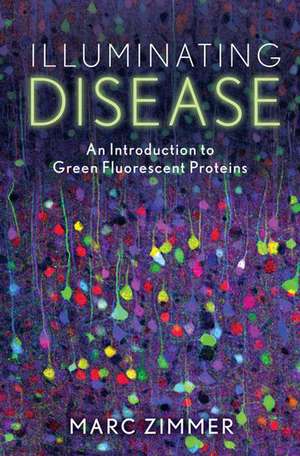Illuminating Disease: An Introduction to Green Fluorescent Proteins
Autor Marc Zimmeren Limba Engleză Hardback – 5 mar 2015
Preț: 303.92 lei
Preț vechi: 367.97 lei
-17% Nou
Puncte Express: 456
Preț estimativ în valută:
58.15€ • 60.72$ • 48.13£
58.15€ • 60.72$ • 48.13£
Carte tipărită la comandă
Livrare economică 24-31 martie
Preluare comenzi: 021 569.72.76
Specificații
ISBN-13: 9780199362813
ISBN-10: 0199362815
Pagini: 240
Ilustrații: 67 color
Dimensiuni: 239 x 155 x 23 mm
Greutate: 0.64 kg
Editura: Oxford University Press
Colecția OUP USA
Locul publicării:New York, United States
ISBN-10: 0199362815
Pagini: 240
Ilustrații: 67 color
Dimensiuni: 239 x 155 x 23 mm
Greutate: 0.64 kg
Editura: Oxford University Press
Colecția OUP USA
Locul publicării:New York, United States
Recenzii
When the Nobel Prize in chemistry was awarded for the discovery of green fluorescent protein (GFP) in 2008, the Nobel Committee called GFP a guiding star for biochemistry enabling processes that were previously invisible, such as cancer cells spreading, to be strikingly visible. Marc Zimmer, has written a glowing accountof how GFP and its red, blue, yellow and orange cousins have revolutionized bio-medical research and enabled every major disease, both cause and effect, to "light-up" in the laboratory for researchers to visualize, understand and eventually conquer them. This exciting and landmark book on the wonderful story of GFP is written with great clarity, warmth and for everyone.
I am tempted to say that this book is to GFP what the double helix is to DNA. Zimmer's pleasant and captivating account features a whole range of scientific problems, framed with personal stories and anecdotes. Zimmer manages to tell stories across many fields of disease (cancer, heart, brain, infections) that are not usually put together into one volume and thus provides a rare unifying read across biology. The nicely illustrated book clearly is a must-read for all students of biology.
For many years, GFP attracted keen attention of scientists because of its unique biochemistry and practical usefulness, and simply due to its aesthetic beauty. Dr. Zimmer describes a lot of facts of medicine and basic biology, but at the same time does not forget to explain all basics to non-scientist readers, often suggesting surprising and illustrative parallels with everyday life. The book is full of stories of people who made key discoveries and technical breakthroughs in the field, and it shows an exciting flow of appearance and implementation of scientific ideas.
Illuminating Disease' achieves a difficult synthesis between discussing various diseases that are rarely mentioned within a single book and the molecular biology of fluorescent proteins without losing accessibility for a generalist reader. It is this mix that makes 'Illuminating Disease' stand out. Zimmer's account will provide students with an access point to the history and application of fluorescent proteins. There really is something for everyone here: from the interested lay-scientist through to the undergraduate student to those researchers that take GFP for granted in their daily research. And it is with this appreciation that the current book will serve the scientific community well.
The book is well written, and the discussion is sufficiently detailed to be useful but not so complex as to overwhelm readers with minutiae. This is an informative read for those in the health science disciplines. Highly Recommend.
I am tempted to say that this book is to GFP what the double helix is to DNA. Zimmer's pleasant and captivating account features a whole range of scientific problems, framed with personal stories and anecdotes. Zimmer manages to tell stories across many fields of disease (cancer, heart, brain, infections) that are not usually put together into one volume and thus provides a rare unifying read across biology. The nicely illustrated book clearly is a must-read for all students of biology.
For many years, GFP attracted keen attention of scientists because of its unique biochemistry and practical usefulness, and simply due to its aesthetic beauty. Dr. Zimmer describes a lot of facts of medicine and basic biology, but at the same time does not forget to explain all basics to non-scientist readers, often suggesting surprising and illustrative parallels with everyday life. The book is full of stories of people who made key discoveries and technical breakthroughs in the field, and it shows an exciting flow of appearance and implementation of scientific ideas.
Illuminating Disease' achieves a difficult synthesis between discussing various diseases that are rarely mentioned within a single book and the molecular biology of fluorescent proteins without losing accessibility for a generalist reader. It is this mix that makes 'Illuminating Disease' stand out. Zimmer's account will provide students with an access point to the history and application of fluorescent proteins. There really is something for everyone here: from the interested lay-scientist through to the undergraduate student to those researchers that take GFP for granted in their daily research. And it is with this appreciation that the current book will serve the scientific community well.
The book is well written, and the discussion is sufficiently detailed to be useful but not so complex as to overwhelm readers with minutiae. This is an informative read for those in the health science disciplines. Highly Recommend.
Notă biografică
Marc Zimmer is Professor of Chemistry at Connecticut College. He has published articles on science and medicine for the Los Angeles Times and the Huffington Post, among many other publications.








